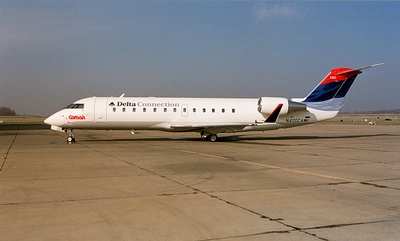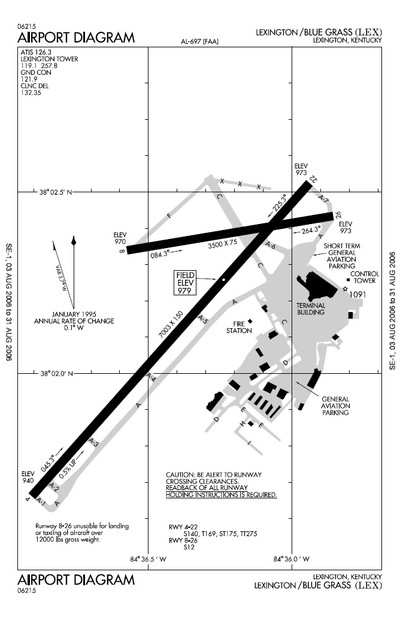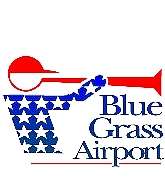What Lessons Have Been Learned... And Have They Been
Heeded?
One year ago today, just after 0600 local time at a small
regional airport in Lexington, KY, a Comair CRJ-100 regional jet
lined up on runway 26, and started rolling on what the flight crew
no doubt thought would be an uneventful, thoroughly routine
takeoff. It wasn't.

No one knows when the two pilots realized their grossed-out RJ
wouldn't be able to lift off before the pavement ran
out... which it did, about half as soon as they initially thought
it would.
As ANN reported, the CRJ
impacted terrain just off the departure end of 26. News-Spy reports
almost immediately pinpointed the primary cause of the accident:
the pilots had tried to take off on 26, a 3,500-foot runway used
only by general aviation aircraft at LEX.
The lone controller on duty in the Blue Grass Regional Airport
tower that morning had cleared the jet to depart from runway 22 --
which, in addition to being twice as long as 26, is also twice as
wide... and lighted.
Of the 47 passengers and three crewmembers onboard the CRJ, only
one survived -- first officer James Polehinke, who was the flying
pilot at the time of the accident.
In the month following the accident, the FAA issued a Safety
Alert For Operators (SAFO) essentially reminding airline pilots to
verify their planes are lined up on the correct runway before
takeoff.

The agency also strongly urged pilots to review all Notices to
Airmen pertaining to their departure airport, particularly to those
concerning taxiway construction and alternate routing -- something
the FAA, and later the National Transportation Safety
Board, said may not have been done by the Comair crew,
despite construction at the airport.
 Investigators also
determined the FAA was partly to blame for the accident, in
staffing the control tower at LEX with one controller -- who was
working his second shift of the day at the time of the crash, with
scant rest in between. The FAA admitted the tower
should have had two controllers on duty... another set of eyes,
perhaps, that may have caught as Flight 5191 lined up on the wrong
runway.
Investigators also
determined the FAA was partly to blame for the accident, in
staffing the control tower at LEX with one controller -- who was
working his second shift of the day at the time of the crash, with
scant rest in between. The FAA admitted the tower
should have had two controllers on duty... another set of eyes,
perhaps, that may have caught as Flight 5191 lined up on the wrong
runway.
On Sunday, family members of those lost in the accident gathered
a public ceremony in Lexington. While the event was meant primarily
to memorialize the victims of the crash, those in attendance also
question whether the government -- relatively quick to determine
pilot error was to blame for the accident -- is doing all it can to
implement safety procedures enacted in the 365 days since.
"Where does it go?" Kevin Fahey, who lost his son Thomas in the
accident, asked the Cincinnati Post. "The action plan to address
these recommendations seems to remain a plan too long and not
become a concrete procedure or stipulation."
The FAA says it doing at it can, as fast as it can. In January,
the agency stipulated graphics of closed
taxiways be included in airport notices to pilots, in
addition to text versions. By October, standardized reports --
direct from the government, regardless of what dispatch operator
the airline uses -- will be in cockpits, to give all crews the same
information.
"We're in the safest period in aviation history, but we don't
want to rest on those successes," said FAA spokeswoman Laura Brown.
"We keep trying to make improvements that will make aviation even
safer."
 Private contractors
have also stepped up to the plate. Just over one week after the
Comair accident, Honeywell Aerospace noted its Runway Awareness & Advisory
System (RAAS, shown at right) might have prevented the
accident from occurring. In a clear voice, RAAS tells flight crews
where they are on the airport -- reducing the chance of a runway
incursion, or a trip down the wrong path.
Private contractors
have also stepped up to the plate. Just over one week after the
Comair accident, Honeywell Aerospace noted its Runway Awareness & Advisory
System (RAAS, shown at right) might have prevented the
accident from occurring. In a clear voice, RAAS tells flight crews
where they are on the airport -- reducing the chance of a runway
incursion, or a trip down the wrong path.
The system has since been certified by the FAA, and six airlines
have equipped some 808 planes with the system, according to the
Post. "Would it have broken the chain?" Honeywell spokesman Bill
Reavis said. "There's no way to speculate."
(Editor's Note -- It's worth noting similar technology is
available to general aviation pilots, as well, in the form of
Hilton Software's SmartTaxi system... available on the WingX 2.0 browser for the
Pocket PC.)
Another company, Aviation Communications Surveillance Systems,
developed a moving-map program in 2005 showing pilots where their
plane is on an airport. UPS is using it... but other airlines may
need to be 'coaxed' by the government, said company spokesman Steve
Henden.
"It's going to take the government stepping up and saying we're
not going to stand for any more accidents related to runway
incursion," Henden said. "Until they're told to do it, they're not
likely to do it."
Despite the progress made, however, some victims' families say
more should be done -- including a more concerted effort to
eliminate "chatter" from the cockpit in the crucial time before
takeoff. Cockpit voice recordings taken from 5191 show both pilots
spoke of such mundanities as work hours and their pets in the
moments leading up to the accident.
"Accidents will happen because sloppiness in the cockpit has
become a habit," said Wayne Turner, who lost his brother in the
crash. "Lives are too precious to afford that kind of
latitude."

Turner suggests random CVR checks, to make sure pilots maintain
a sterile cockpit at crucial times.
 ANN's Daily Aero-Linx (04.13.24)
ANN's Daily Aero-Linx (04.13.24) ANN's Daily Aero-Term (04.13.24): Beyond Visual Line Of Sight (BVLOS)
ANN's Daily Aero-Term (04.13.24): Beyond Visual Line Of Sight (BVLOS) Airborne 04.09.24: SnF24!, Piper-DeltaHawk!, Fisher Update, Junkers
Airborne 04.09.24: SnF24!, Piper-DeltaHawk!, Fisher Update, Junkers Aero-News: Quote of the Day (04.14.24)
Aero-News: Quote of the Day (04.14.24) ANN's Daily Aero-Term (04.14.24): Maximum Authorized Altitude
ANN's Daily Aero-Term (04.14.24): Maximum Authorized Altitude







